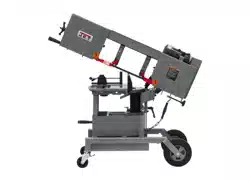Loading ...
Loading ...
Loading ...

16
8.3 General operating procedure
IMPORTANT: When cutting magnesium, never use
soluble oils or emulsions (oil-water mix) as water will
greatly intensify any accidental magnesium chip fire.
See your industrial coolant supplier for specific
coolant recommendations when cutting such
material.
1. Give machine an overall inspection. Verify that
all guards, covers, etc. are in place and in
working order, the blade is tensioned properly
and tooth direction matches arrow on bow.
Check that blade guides are set correctly.
2. Position bow for desired angle of cut.
3. Adjust movable blade guide to minimize
exposed blade area.
4. Raise bow until it will clear workpiece by a few
inches, and secure in position by closing
cylinder valve.
Always secure bow in
raised position before loading material.
Never start a cut with blade contacting
workpiece.
5. Position workpiece in vise and clamp it
securely. Workpiece should be fitted directly
between the jaws without adding other objects.
When workpiece is profiled section, flat piece or
special shape, refer to examples in Figure 8-1
for proper clamping positions.
If the thickness of profile section is very thin, a
piece which duplicates the profile should be
fitted inside the workpiece itself, to prevent
workpiece being crushed between the jaws.
Do not load/unload material
from vise while machine is running. Never hold
workpiece by hand when cutting; workpiece
must be firmly secured in vise. Do not reach into
cutting area during cutting operations.
6. Set suitable feed rate on cylinder dial.
7. Turn on saw and allow to reach full speed. Start
coolant flow (if applicable).
8. Open valve on hydraulic cylinder to allow bow
to descend in gradual and controlled manner.
9. Stop screw must turn off saw at completion of
cut.
Figure 8-1: clamping positions
8.4 Evaluating cutting efficiency
Is the blade cutting efficiently? The best way to
determine this is to observe the chips formed by the
cutting blade.
If chip formation is powdery, then the feed rate is
much too light, or the blade is dull.
If chips formed are curled, but colored — that is,
either blue or straw-colored from heat generated
during the cut — then the feed rate is too high.
If chips are slightly curled and are not colored by
heat – the blade is sufficiently sharp and is cutting
at its most efficient rate.
Loading ...
Loading ...
Loading ...
